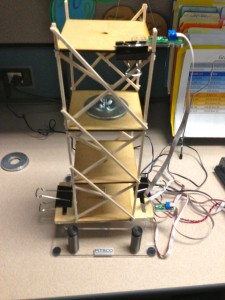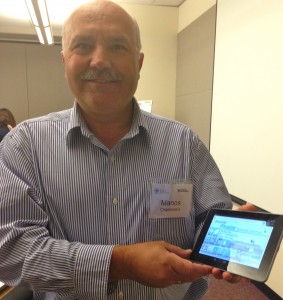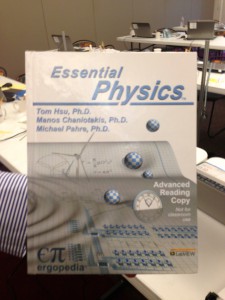By LAURA LOREK
Founder of Silicon Hills News

An earthquake simulator that runs on National Instruments’ LabView software.
Simulating an earthquake on a wooden building model equipped with sensors or studying energy flow on a miniature power plant and power grid.
Those are a few of the hands-on activities for high school kids to learn about physics thanks to a program created by
National Instruments.
The Austin-based company has created a curriculum for Texas physics teachers to give their students hands-on experience with different subjects and concepts and to teach them how to apply mathematical models to real-world data.
The programs, powered by National Instrument’s
LabVIEW software, provide real-life experiments that bring textbooks to life.
And on Wednesday and Thursday, 29 high school science teachers learned about new ways to teach physics at National Instruments’ corporate headquarters.
They are part of the
Texas Regional Collaboratives for Excellence in Science and Mathematics Teaching’s first program at National Instruments to expose the teachers to real-world applications of physics and engineering and show them how to teach that in a compelling way to students in a classroom. More than 60 teachers applied for the program, said Carol Fletcher, associate director of TRC. She chose teachers from many disadvantaged school districts and those who would have the best ability to train others, she said.
All of the technology and entertainment kids get exposed to today tends to dilute their curiosity, said Antonio Gomez Pedroso, physics teacher at Longview High School in East, Texas, who was attending the training.
“You have to do big stuff to get their attention,” Pedroso said.

Ray Hsu, Senior Program Manager, K-12 Education
at National Instruments
Ray Hsu, senior program manager with National Instruments, understands that challenge. He has been designing K-12 education programs for students for the last three years. National Instruments needs engineers and they know about the shortage of workers in the Science, Technology, Engineering and Math, known as STEM, fields in the United States.
“We can be viewed as a customer of the education system,” Hsu said. “We’re trying to reach out and be an industry involved in bringing real world experiences to the classroom.”
National Instruments, which has been involved in the
First Robotics program since 2006, is committed to making a substantial impact on the STEM education of kids, Hsu said.
The idea comes from the principle of shared value “which involves creating economic value in a way that also creates value for society by addressing its needs and challenges,”
according to the Harvard Business Review. “Businesses must reconnect company success with social progress. Shared value is not social responsibility, philanthropy, or even sustainability, but a new way to achieve economic success. It is not on the margin of what companies do but at the center.”
National Instruments has taken that philosophy to heart, Hsu said.
In 1998, NI engineers created a version of its
LabVIEW software for Lego Mindstorms designed for use with the Lego Education robotics platform. And all of the robotic controllers and robots used for the
First Robotics competition run on the LabVIEW software platform.
LabVIEW is a system design software used by engineers and scientists to design and control applications. Elon Musk’s SpaceX uses LabVIEW “systems to control launchpad equipment and to command and monitor the Falcon 1 and Falcon 9 launch vehicles and its Dragon spacecraft,”
according to National Instruments. Those are the kinds of cool applications that spark student’s interest, Hsu said.
“Engineering is not as well understood in the K-12 space,” Hsu said. “We want to change that. We want to take it to another level. We want to change the classroom.”
National Instruments created a data acquisition tool called myDAQ, which sells for $175, and connects via a USB port to a computer. It partnered with
Pitsco Education to create an earthquake table. With the myDAQ device and the earthquake table students can study the effects of earthquakes. National Instruments also created a curriculum as a guide for teachers and students “Understanding Structures & Earthquakes.” The booklet is the first of 12 specialized physics curriculum National Instruments is creating. The other two that are currently available include “Discover Heat Transfer” and “Explore Power and Energy.”
“Teaching is an art,” Hsu said. “If they can get students to start asking questions then they’ve got them.”
National Instruments is also working with Carnegie Mellon University to create a pathway for students to get certified in LabVIEW with a badging system to mark each of their milestones. It’s all about making real life engineering work relevant and engaging to students, Hsu said.
During this week’s two-day training session at National Instruments, teachers learned how to teach lessons on the properties of waves and sound including frequency, wavelengths, the Doppler effect, resonance and more.

Manos Chaniotakis, with Ergopedia and one of the authors of a new physics textbook.
Tom Hsu and Manos Chaniotakis, with
Ergopedia and authors of a new physics textbook, led the instruction.
“Our focus is to make sure we get reality into the curriculum,” Chaniotakis said.
Texas is going through adoption of a new physics textbook for the first time in 11 years. The latest book emphasis hands-on learning, said Chaniotakis. It has an e-book component, which can be accessed by computer, tablet or smartphone. It features videos, illustrations and more features that extend the paper textbook and provide the student with more opportunities for learning.
“Hands on is the key,” Chaniotakis said. “You learn better by doing something.”
Unfortunately, Texas lawmakers just passed
H.B. 5, which makes physics and optional class for high school students, Hsu said.

Joni Milanovich, a physics teacher with Roosevelt High School in San Antonio, liked the training at National Instruments and the new textbook and the interactive approach to teaching.
“It’s vey hands on,” she said.
If she gives her students a paper assignment, they won’t do it often, she said. But if it’s on the computer, they are more engaged, she said.
“They are used to using electronics and equipment to do their homework and labs,” she said.
National Instruments’ technology focused on the K-12 market will be on display next week at the U.S. News STEM Solutions Conference, June 17-19 at the Austin Convention Center.

